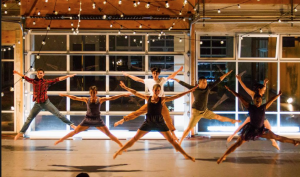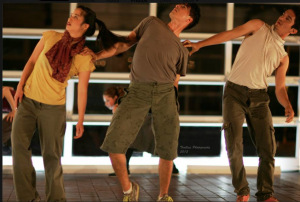San Diego Dances at Bread & Salt … and Provides a Full Meal
Gaga. Opera. A foot-stomping dance-off with tap, flamenco, and Bharata Natyam artists shaking the floor. The PGK Dance Project’s “San Diego Dances” kept the thrills coming.
The excitement began with the venue for the latest edition of this traveling show, which has been held in a beauty salon, Spanish Village, the lobby of the Spreckels Theatre, and elsewhere. This time (March 6-8), PGK chose Bread & Salt, a former bakery in Logan Heights that’s been transformed into an arts space. It’s glorious, with so many airy, expansive areas that pieces were staged in three different settings, the audience moving and mingling between them.
Then there was the work. “San Diego Dances” showcases multiple choreographers—even, this time around, a new opera company—and PGK director Peter G. Kalivas lined up a stellar group of artists, starting with somebodies dance theater, whose “Eyes East” opened the show.
somebodies’ directors Gina Bolles Sorensen and Kyle Sorensen spent last year in Israel and studied Gaga, the movement practice developed by Ohad Naharin of the Batsheva Dance Company. This is their first work that I’ve seen since they returned, and it has Gaga’s sensuous fluidity, the impression that each movement originates deep in the body and spreads through every cell … which sounds yummy and oozy but can also, as in this piece, produce speed and attack—whip turns, frantic pivots, sudden percussive bursts. I’d need to see “Eyes East” several times to appreciate all the choreographic invention, and it would be a pleasure. Some of the six dancers in the strong cast look more at home in the style than others—April Tra seems born to move this way—but, as the Sorensens develop their company, I anticipate more bodies here will start speaking fluent Gaga.
In “Reinventing Home,” Anjanette Maraya-Ramey cleverly used a big garage-type door at the rear of the performance space to represent the border; it gets “crossed” by Viviana Alcazar-Haynes and Nguyen Bui, as recorded voices recount immigrant experiences. (The score was designed by the fine Kristopher Apple, a violinist who’s become the go-to musician for the dance community.) Having Shannon Snyder as an immigration agent was overly literal. I would have liked to see this piece get across the perils of being undocumented more through the sense of struggle between delicate, lovely Alcazar-Haynes and sturdy Bui.
A gallery space was the site for a taste of a new local opera company. San Diego City Opera is developing a retelling of “Dido and Aeneas” with the Henry Purcell music and a new libretto. Sarah Klacka sang an aria from the final scene, pasting herself dramatically to the walls and columns, with Alexis Rouse accompanying on viola.
We moved to the Brick Room for the rest of the show, the shifts in location giving everyone a chance to notice that, unlike the Medicare-skewing audiences (such as myself) at many other performance genres, this dance show was attracting a refreshingly young crowd. Presenters looking to broaden your appeal, pay attention!
Alyssa Junious, Chad Ortiz, and John Paul Larson were a taut, athletic trio in “From a Whisper,” by Kim T. Davis, a professor of dance at Modesto Junior College. I loved the flying leap Junious took into Ortiz’s arms.
Blythe Barton’s “Cinema of a Certain Tension” began with the dancers warily circling one another and sometimes connecting, to a lyrical song from the Trent Reznor/Atticus Ross soundtrack to the very tense “The Girl with the Dragon Tattoo.” The music changed to a percussive, driving piece from the same soundtrack, and the mood of prickly caution gave way to abandon, with fast kicks and reaching arms, the seven dancers forming urgent groups of three and four. It was a thrill at the end when Larson was alone on stage, jumping.
Choreographer Viviana Alcazar-Haynes and solo dancer Zaquia Mahler Salinas dedicated “Josephina” to their grandmothers. This charming piece began with a video (uncredited) of a big family gathering, the grandmother at the stove cooking. Salinas, in a housedress and apron, initially sat at a table onstage and watched. Then she began moving, stirring a pot at an onstage stove, approaching the audience with big open arms and a sweet smile. She kept moving out from but returning to a rug, as if maintaining her connection to home even as she ventured into the world.
Rosalia Lerner is a San Diego native who has trained and performed in Europe, New York, Portland, and the Bay area. In her drolly feminist “Generally speaking, women tend to___,” four women in perky polka-dot frocks ran diagonally but stopped short, as if they’d hit an invisible force field. They mimed putting on makeup, then broke into bits of dialogue—”I’m sorry.” “I totally understand.”—essential phrases with which women get through life. I totally understood. I wasn’t surprised to find out that Lerner has worked with the brilliant dance-satirist Joe Goode. I hope this piece, which felt incomplete in this showing, is part of a longer project.
A felicitous combination of site and performance occurred in Kalivas’s “The Sound of Dance.” The slightly raised wooden stage in this part of Bread & Salt was an ideal sound-board for hoofer John Paul Lawson, flamenco dancer Kristina Covarrubia, and Bharata Natyam artist Divya Devaguptapu. The piece started in darkness, with only the sound of six feet stomping. In a nice balance between solos and group work, the three played “start the rhythm,” did some dance challenges, and occasionally came into semi-unison.
The next two pieces were the only disappointments on the program. Natasha Ridley’s yearning solo, “Finding the light part 1,” felt undeveloped as choreography.
And I’m still, days later, puzzled by Kalivas’s “Why the Arts Matter/Tell the Story Before They Do.” The piece had a lot going for it. The sound score was a speech given by Michelle Obama, re-interpreted by San Diego artist Nate Howard. And I liked quite a few elements of the choreography: the seven dancers in a scrum, a backwards run, a transition from tight stillness to jumps. But I kept wondering why these dancers, who all looked great in other pieces, seemed less skilled and assured here. Maybe they were under-rehearsed? Maybe Kalivas is deliberately showing the effort, as Mark Morris sometimes does?
Kalivas certainly has the skill to make his dancers look terrific, as they did in a flirty Broadway-style finale. He’s also a generous, inventive presenter. “San Diego Dances at Bread & Salt” was a magical combination of art and setting.

Award-winning dance journalist Janice Steinberg has published more than 400 articles in the San Diego Union-Tribune, Dance Magazine, the Los Angeles Times, and elsewhere. She was a 2004 New York Times-National Endowment for the Arts fellow at the Institute for Dance Criticism and has taught dance criticism at San Diego State University. She is also a novelist, author of The Tin Horse (Random House, 2013). For why she’s passionate about dance, see this article on her web site, The Tin Horse


